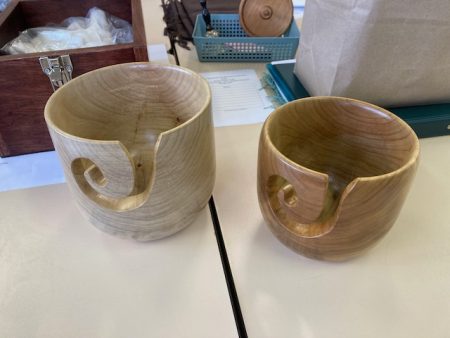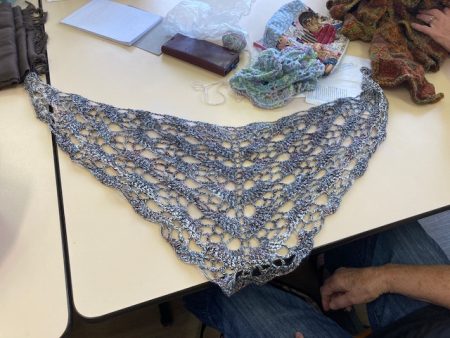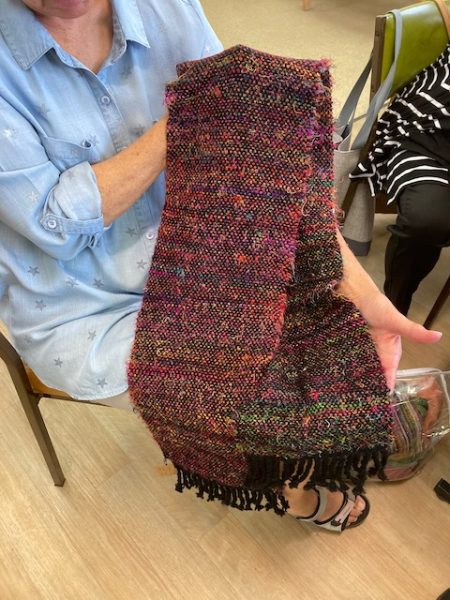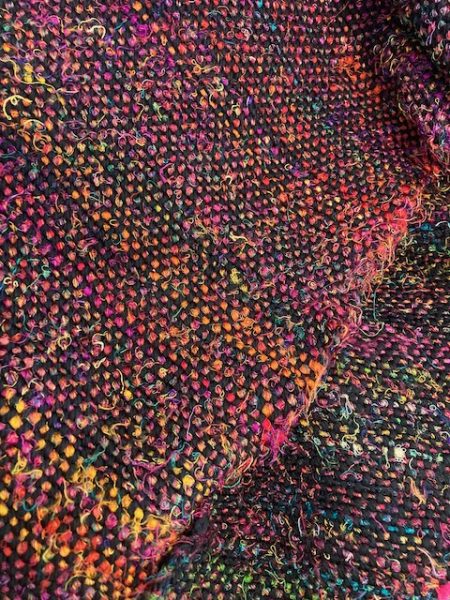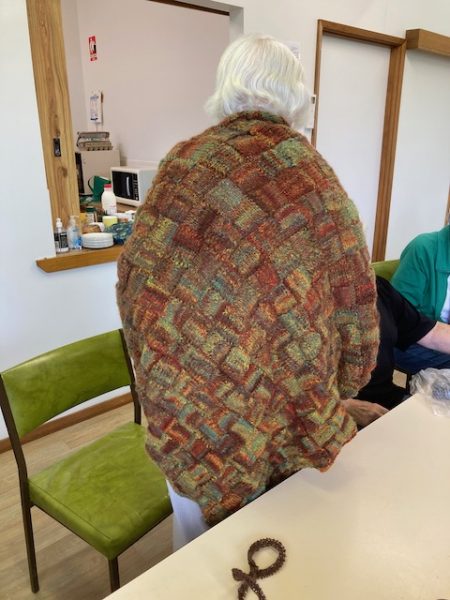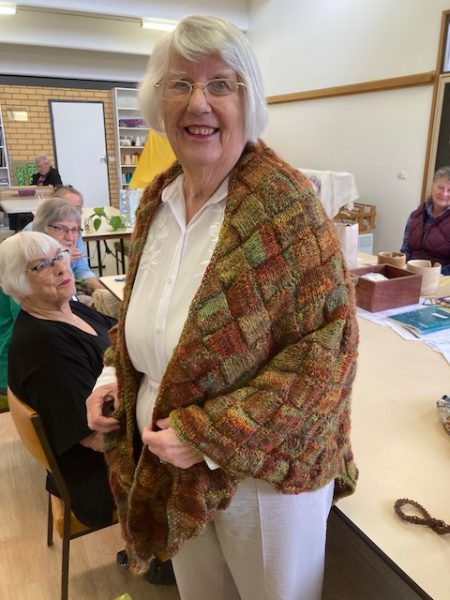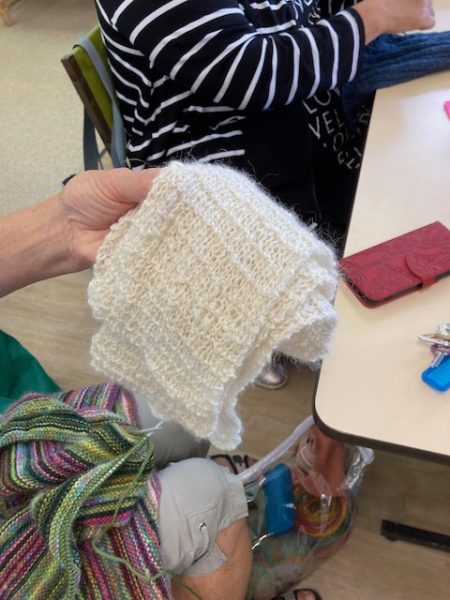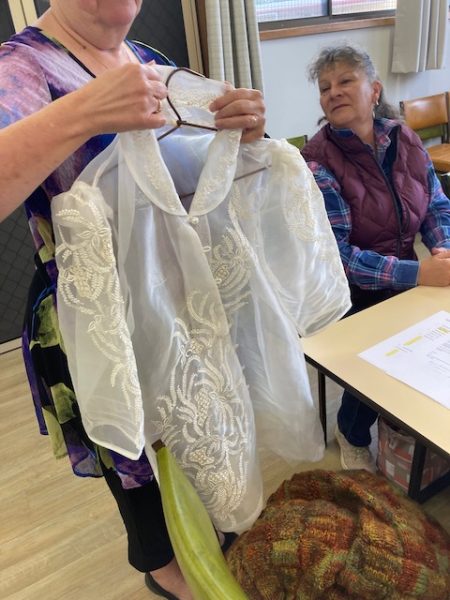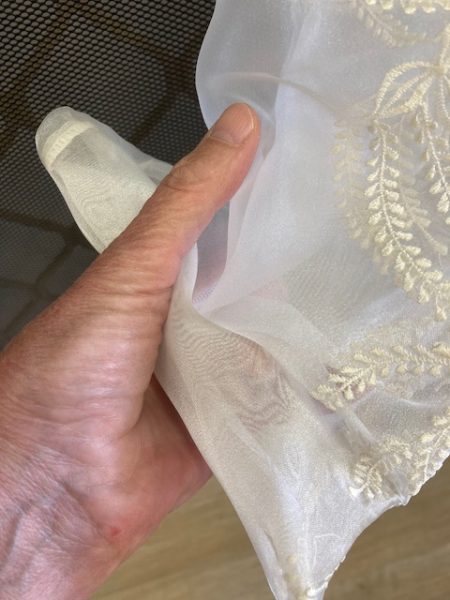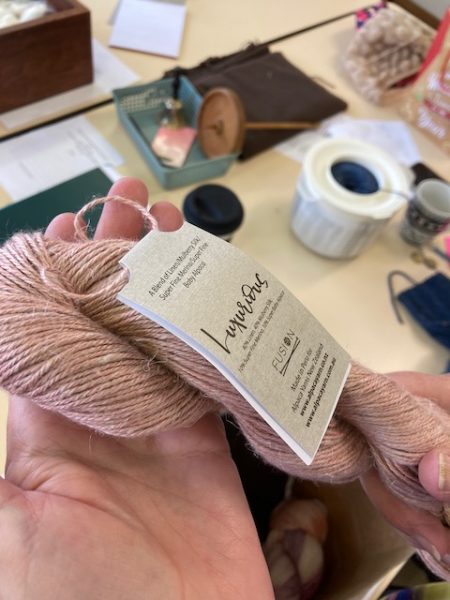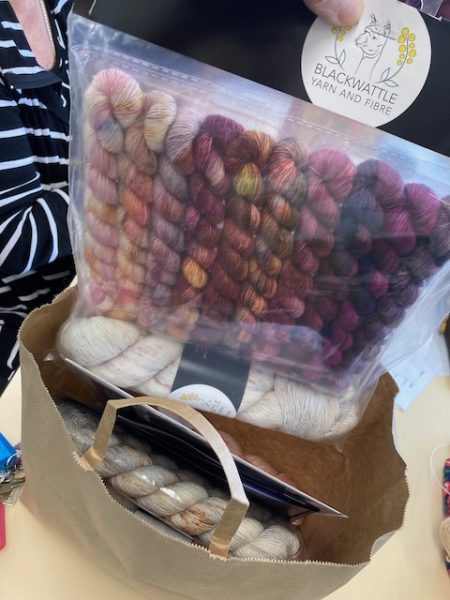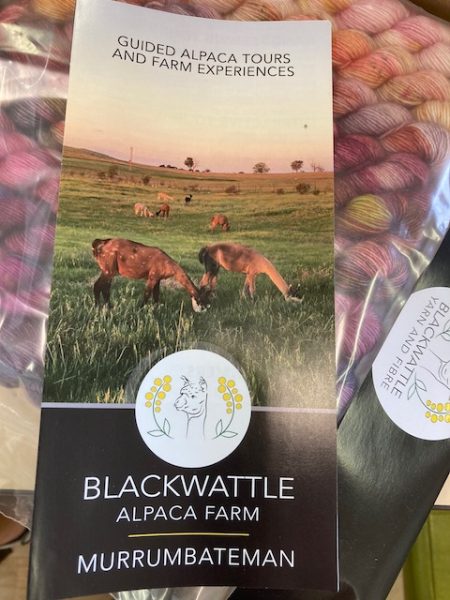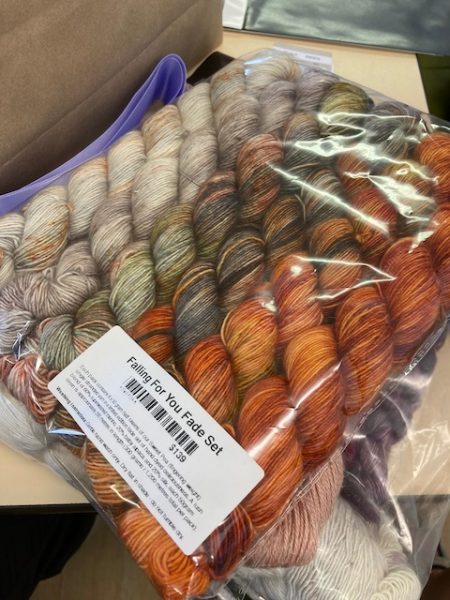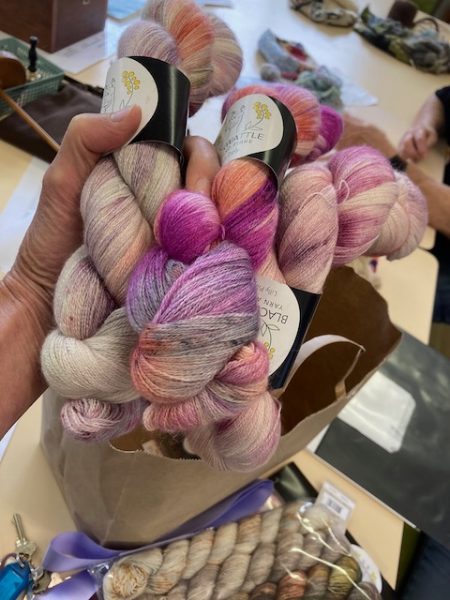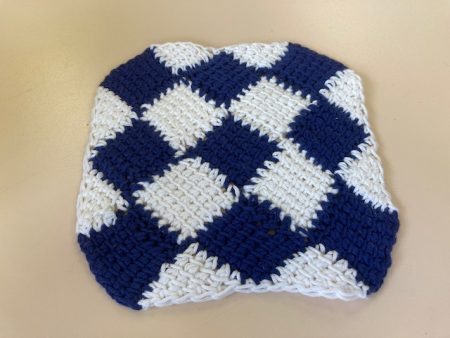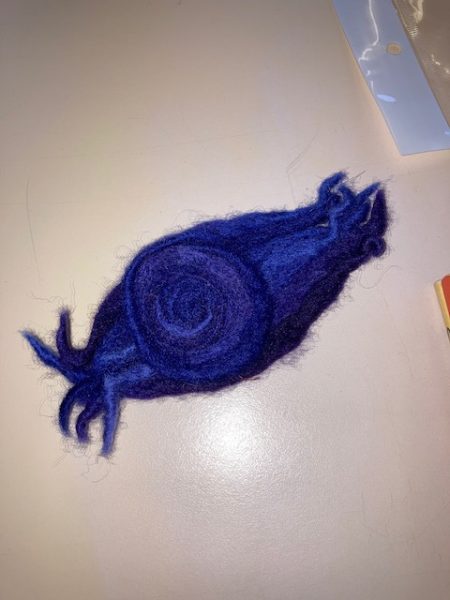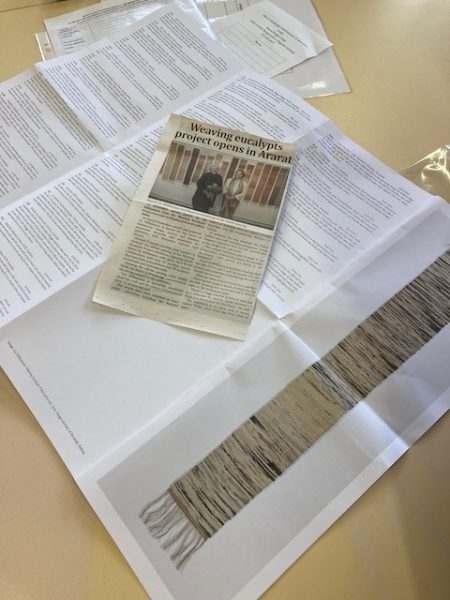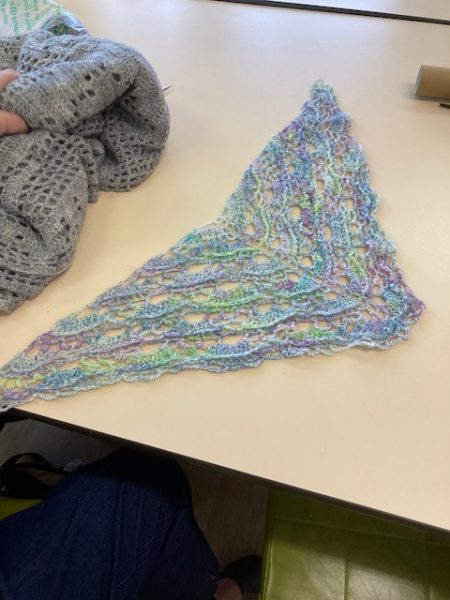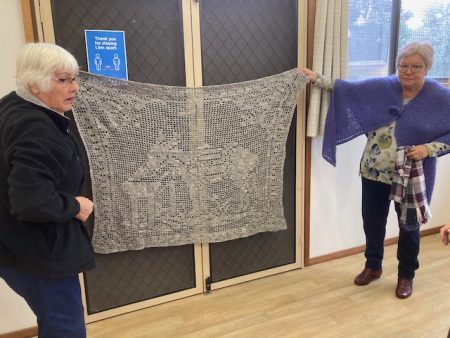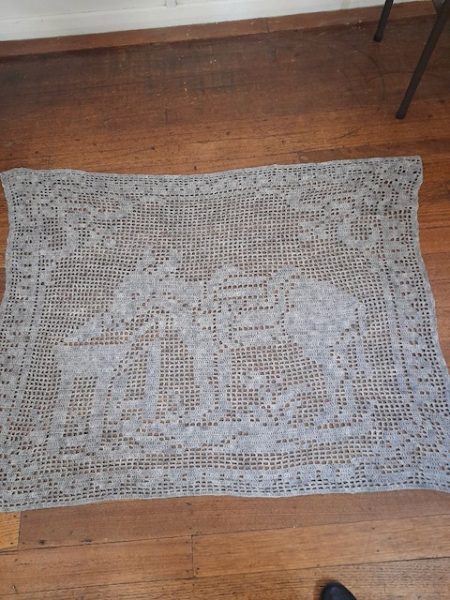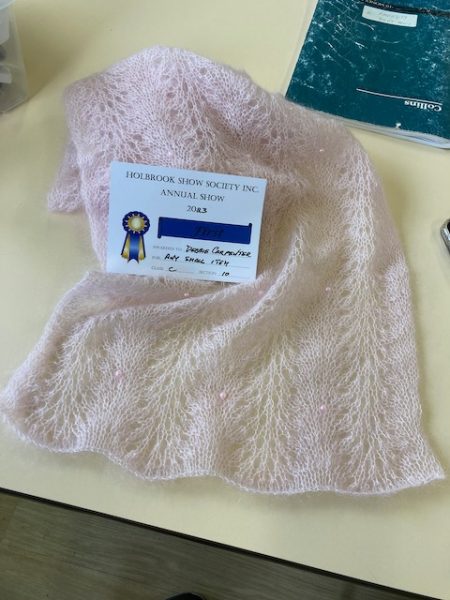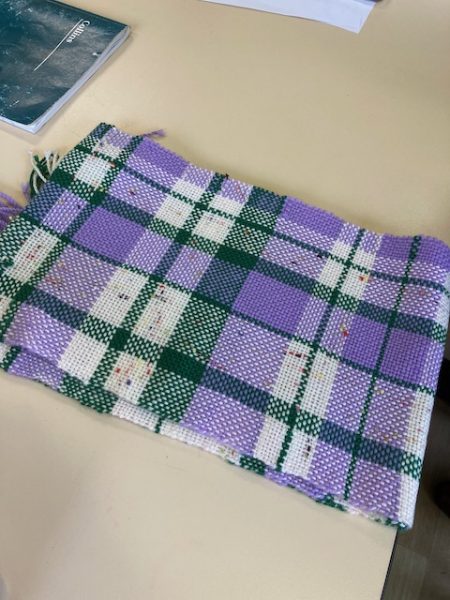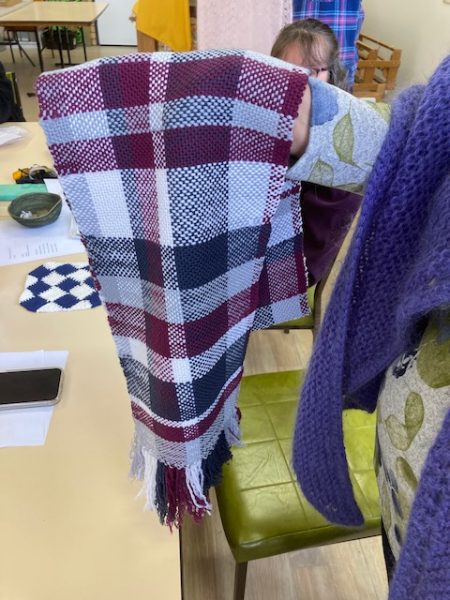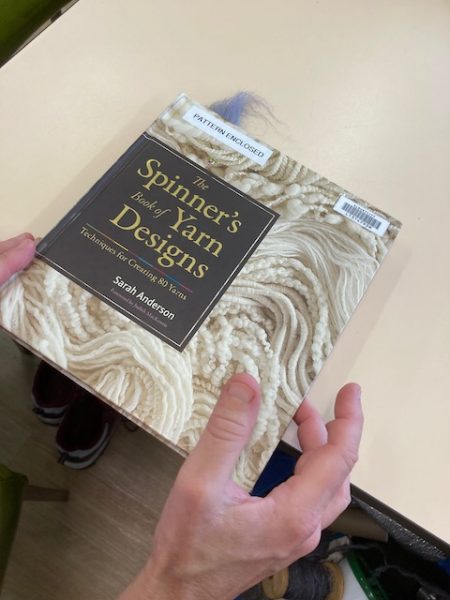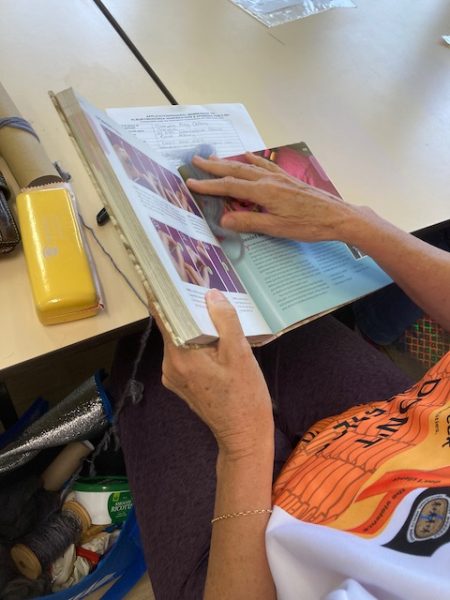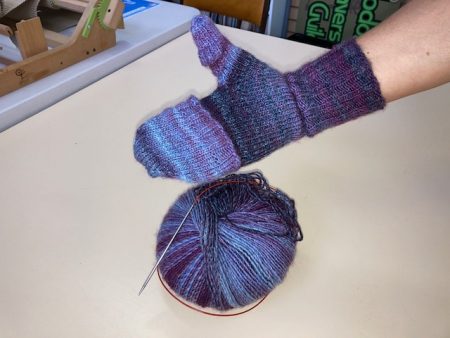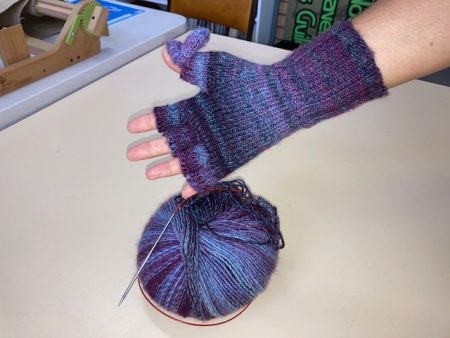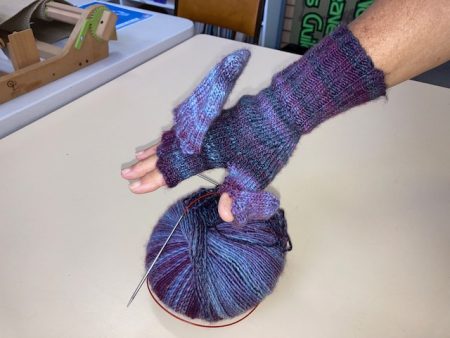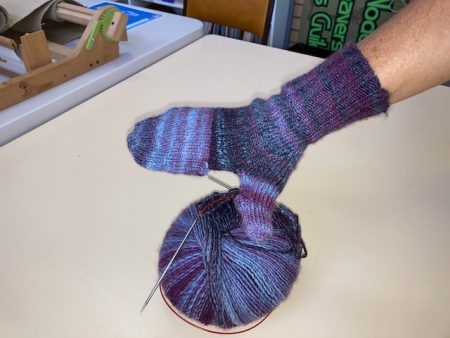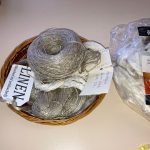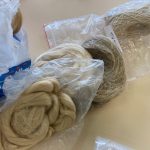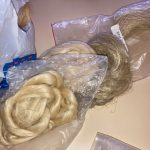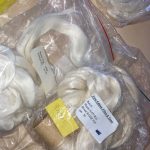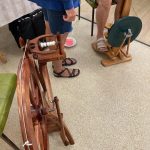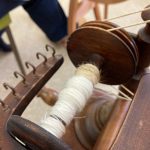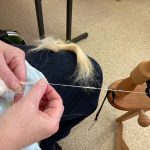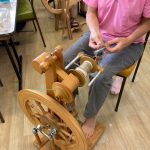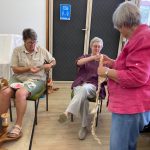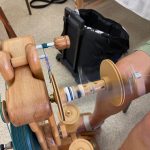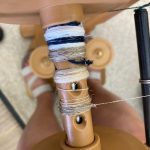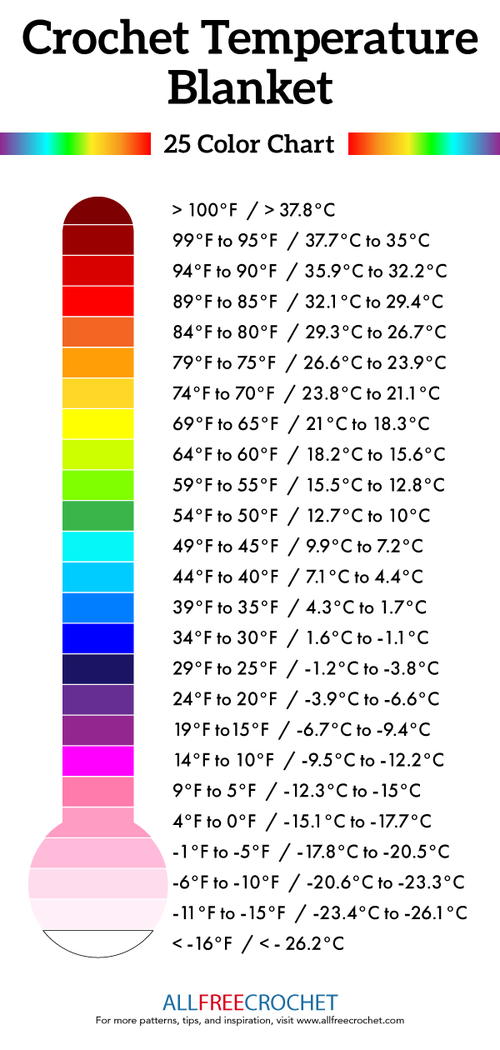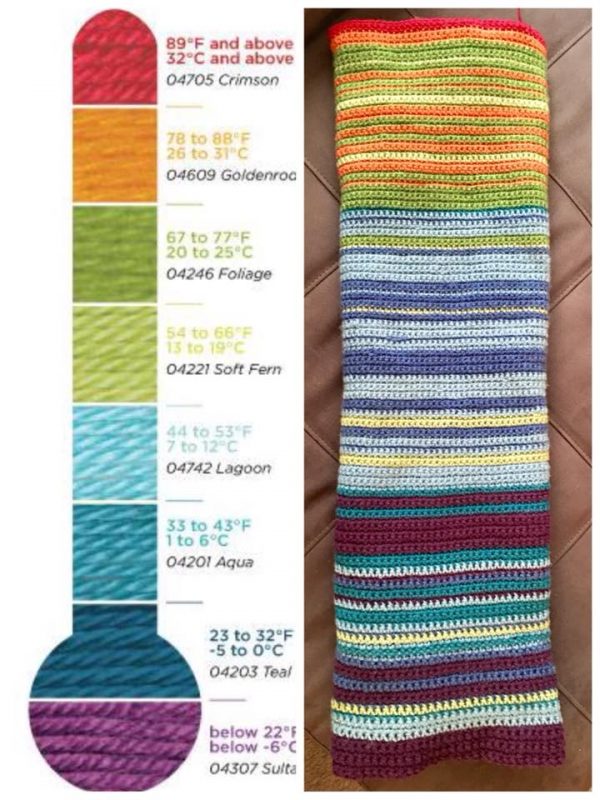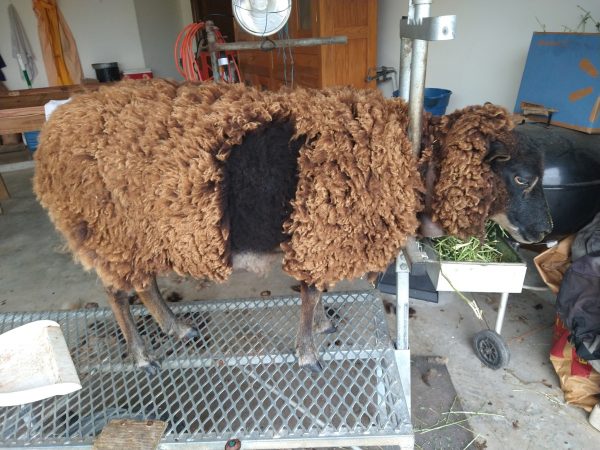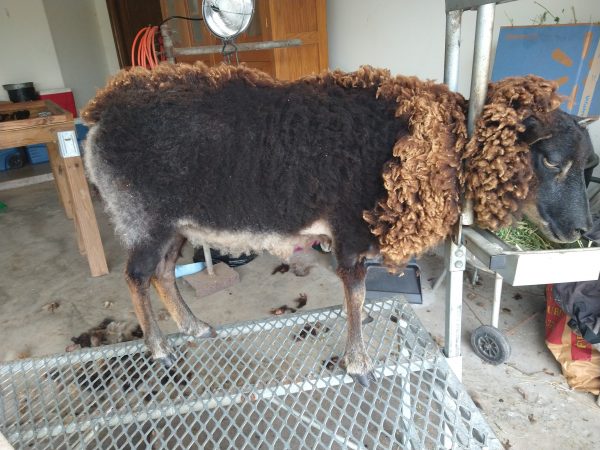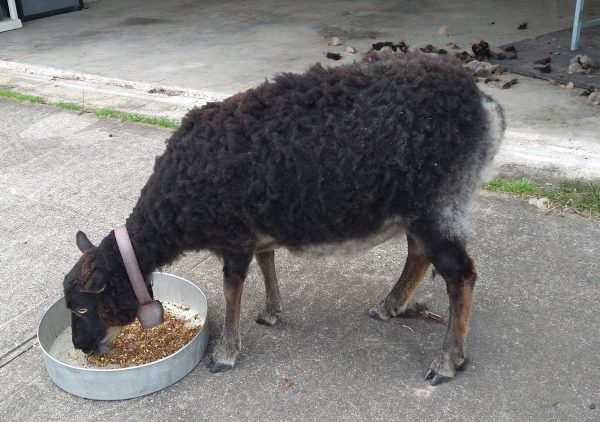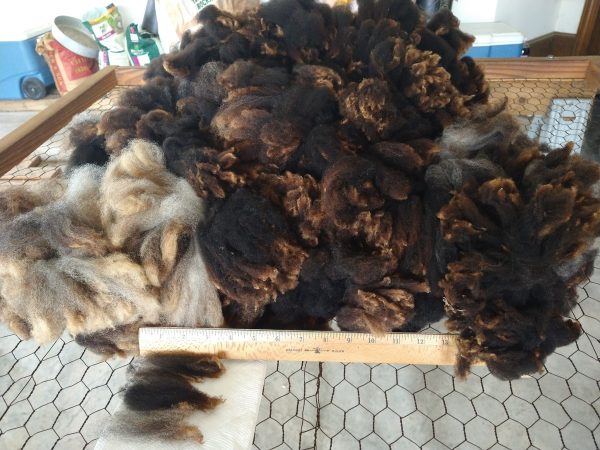
Autumn colours are here …
We’re well into the year and Workshops are already underway. Many enjoyed Heather’s flax and ramie spinning workshop and it was nice to see quite the collection of wheels and a number of Members taking part. The spinning was fun and the fibers challenging. A great learning exercise. Jane has crocheted us some dish cloths with hers and donated them to the kitchen.
The Holbrook Show has been and gone, and we had Guild Members demonstrating at the Show, entering classes and holding displays. A number of Members came back with a prizes. It was one of the hottest days in March, summer’s last fling, and Pam gave us a bit of a health scare but has bounced straight back.
Easter holidays has seen a number of members away on holidays and/or tied up with family duties. We’ve also had a number of new Members join. Chats around the table at our weekly meet-ups has seen a number of plans for future workshops hatched, as well as discussions and swapping of fiber news, hints and tips. New Members are always welcome to our Wednesday Guild days, and there is usually someone there to help aspiring new spinners or weavers. With the breadth of fiber related discussions that usually happen every Wednesday, many a new Member has come away finding there is a lot more that can be learnt and experienced at the Guild.
After our Holiday Season hiatus and a busy few months, we have two Meetings worth of Show & Tell to catch up on so on with the Show …
Cheers all,
KathyW, Editor.

| Current and Upcoming Events | |
|---|---|
| April 26th | Entrelac crochet with Julie |
| May 3rd | Casual Workday |
| May 10th | Business Meeting |
| May 17th | Casual Workday |
| May 20th & 21st | Canberra Wool Expo, old Bus depot Markets |
| May 24th | |
| May 31th | Casual Workday |
| June 7th | Casual Workday |
| June 14th | Business Meeting |
| June 21st | Casual Workday |
| June 28th | Demonstrations of Navajo/Chain Plying & Andean Plying |
Committee 2022 – 2023
President:
Jane Manning
Vice President:
Debbie Carpenter
Minute Officer:
Rhonda Delahoy
Secretary(communications/events):
Julie Hofer
Assistant Secretary:
Amanda Eaton
Treasurer:
Loraine Parker
Assistant Treasurer:
Rhonda Delahoy
Newsletter Editor:
Kathy Wheeler
Library Equipment Officer:
Rhonda Delahoy
Social Media Officer:
Kathy Wheeler
Public Officer:
Julie Hofer
KeyHolders Roster
Wednesday Work Days and Meetings
1st Wed of month – Pam J
2nd Wed of month – Jane or Julie
3rd Wed of month – Heather or Rhonda
4th Wed of month – Loraine
5th Wed of month *IF* there is one – tba
| Morning Tea Roster 2023 – Business Meetings | |
|---|---|
| 8th February | Amanda/ |
| 8th March | Heather/Rhonda |
| 12th April | Sabine/ |
| 10th May | Loraine/ |
| 14th June | Julie/Jane |
| 12th July | |
| 9th August | Louise/Kathy |
| 13th September | Ella/Jill |
| 11th October | Judith Jones |
| 8th November | Amanda |
| 13th December | Everyone bring a plate!!! |
Show & Tell - 8th March 2023
Jane
Jill
Heather
Veronica
First completed skein of grey/red/cream art yarns hand spun from unknown fibre. (Sorry no photo)
Show & Tell - 12th April 2023
Julie
Heather
Jill
Deb
Sandra
Jane
- Workshop -
Spinning Linen and Ramie
with Heather.
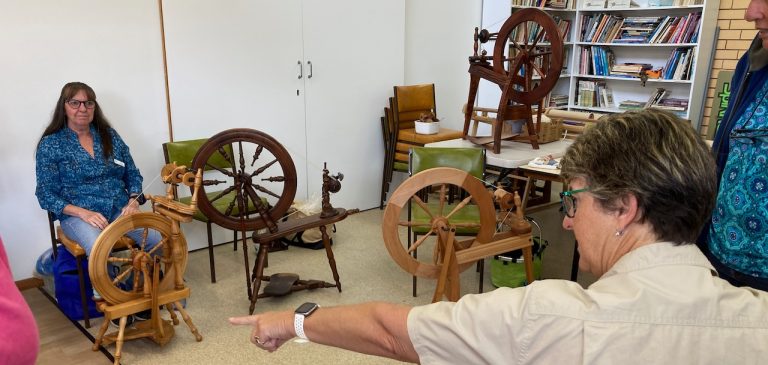
Flax (spun into Linen) and Ramie are both plant fibres are bast fibres , which means the inner bark surrounding the stem of the plant. The fibres must be separated from the woody core by a process of retting (or rotting) which can be performed by microorganisms on land or in water or by chemicals.
Flax has been cultivated for its fibre since Neolithic times, it has been found in predynastic Egyptian cloth and was used by the Swiss Lake Dwellers.
Ramie has been produced in China for over 5,000 years and is sometimes referred to as China Grass. Ramie was also used in early Egyptian burial cloth.
To spin both Flax and Ramie a high twist is best, without letting the twist run into the fibre in the drafting hand. Damp fingers will help smooth the fibres.
Members tried out their spinning skills with fine bleached linen, a medium coarse sample and a fairly coarse unbleached sample. Each has its own uses and generally the opinion was that it was fun to spin and not at all difficult.
Ramie, which is white and shiny and silk like, can be spun into a very fine, strong thread and blends well with cotton, silk and wool. Because of these properties I think the favourite on the day may well have been Ramie.
Thanks to those that joined in with our workshop and made it a fun few hours.
Knit 1, crochet 1, weave 1 ?!?!?
Knit or Crochet a Temperature Blanket (or Scarf)
A temperature Blanket is a Crochet or Knit (or even woven)record of the maximum (or minimum) temperature of each day throughout a set period. A year, or a season or a pregnancy, for example. Predetermined temperature ranges are matched with associated yarn colours.
For example:
Above 40Deg – dark Red
39- 35 red
34- 30 dark yellow
29-25 beige …….
If you lack confidence in choosing colours, use a wool chart, similar to the type distributed by Bendigo Woollen mills to choose colours. Keep a record of the Maximum temperature of the day and knit or crochet a row or two in the contrasting colour.
There are no hard and fast rules to follow and plenty of information on the Internet.
Fibonacci and hailstone sequences make for some interesting stripes in your work whether knitting, crochet or weaving. Have fun. Heather.
Fleecy Follies
Most Members are familiar with shearing sheep and alpacas, and many will also be aware of Australian self shedding sheep, although their fleeces are not usually very good for our purposes. BUT there are some some primitive sheep breeds with valuable fleeces that can shed, and their fleece is often collected in a process known as rooing.
In some sheep breeds, there is a natural break in the growth of the wool in spring. By late spring this causes the fleece to begin to peel away from the body, and it may then be plucked by hand without cutting – this is known as rooing.
The following story and photos are reproduced with permission from the Shave ‘Em to Save ‘Em FaceBook Group and Foggy Hollow Ranch Shetland Sheep. Kolbie is a Shetland ewe:
“Today was Kolbie’s turn to be rooed. She was more than ready to be rooed because she had loose fleece and a long new fleece underneath the old one. Some indicators that she was ready was there was no fleece on her tail, her belly fleece had mostly fallen off, and there were sections of fleece rolling off of her. Such a joy to spend time with my sheep and appreciate the fleece she has grown!
“Not all Shetlands can be rooed, some of the sheep hate it so they are scissor sheared instead. Kolbie was very patient and didn’t mind the pulling even though the new fleece was fairly long.”
The fleece is remove by hand – plucking or rolling.
Shetland sheep are a heritage breed in the UK. A small number were imported to Tasmania in the early 1800’s:
“Only 7 of the 12 sheep shipped on the “William Mitchell” from Leith arrived in Hobart in June 1839. Writing later in ‘The Narrative of Golf Hill’ George Russell, whose brother Phillip was Capain Wood’s manager at Dennistoun said, “they did not succeed well, being so very wild; they could not keep them in any enclosure. Captain Wood’s idea was that the soft downy wool which grows next to the skin of these sheep, and under a coating of hair, would become more valuable in the climate of Tasmania than it was in Shetland. But they were not a success.”
While Shetlands are not bred in Australia, their fleeces and processed fiber can be sourced from local and international suppliers.
The important thing to remember with ANY imported material are the biosecurity issues. Raw fleeces are a big no-no. Any product where the supplier admits there may be some VM remaining should also be avoided.
If you have any doubts about the origins or safety of a fleece product you can check at the Australian Government website:
Biosecurity Import Conditions system (BICON)
Do you have a funny or amazing fiber animal story? If you’d like to share it in a future Newsletter contact the Editor.
2023 Program
| April 26th | Entrelac crochet with Julie | |
| May 3rd | Casual Workday | |
| May 10th | Business Meeting | |
| May 17th | Casual Workday | |
| May 20th & 21st | Canberra Wool Expo, old Bus depot Markets | |
| May 24th | ||
| May 31th | Casual Workday | |
| June 7th | Casual Workday | |
| June 14th | Business Meeting | |
| June 21st | Casual Workday | |
| June 28th | Demonstrations of Navajo/Chain Plying & Andean Plying | |
| July 5th | Casual Workday – Annual Cleanup | |
| July 12th | Business Meeting | |
| July 14th – 16th | Australian Sheep & Wool Show (Bendigo) | |
| July 19th | Casual Workday | |
| July 26th | Christmas in July needle felted decorations with Kathy | 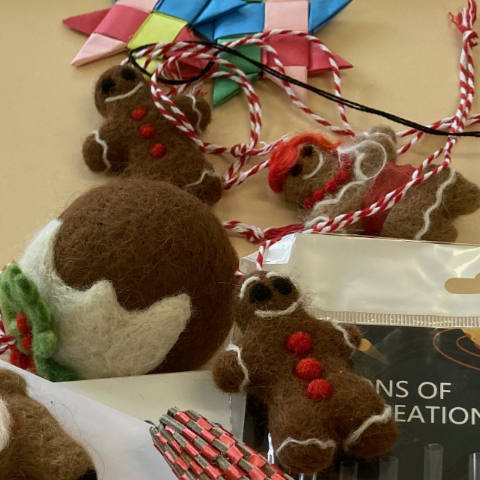 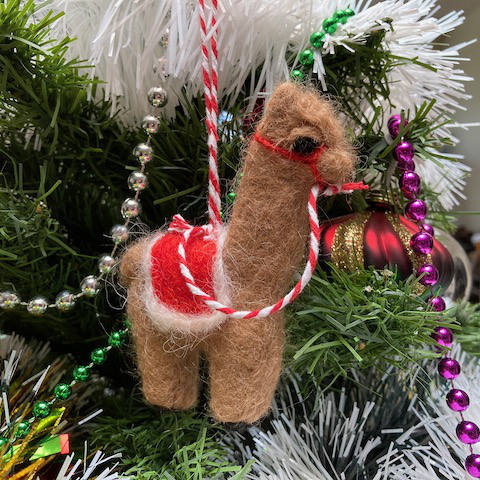 |
| August 2nd | Casual Workday | |
| August 9th | AGM, Business Meeting & Guild’s Birthday | |
| August 16th | Casual Workday | |
| August 23rd | Top Down knitting | |
| August 30th | Casual Workday | |
| September 6th | Casual Workday | |
| September 13th | Business Meeting | |
| September 20th | Casual Workday | |
| September 27th | ||
| October 4th | Casual Workday | |
| October 11th | Business Meeting | |
| October 18th | ||
| October 25th | Rooms closed (Albury Show) | |
| November 1st | Rooms closed (Albury Show) | |
| November 9th | Business Meeting | |
| November 15th | Casual Workday | |
| November 22nd | Lavender Wands with Kathy | 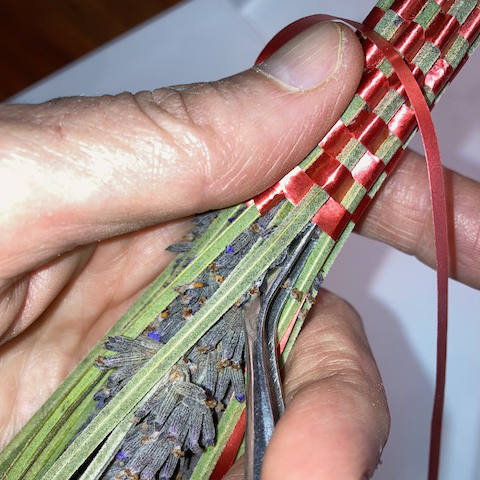 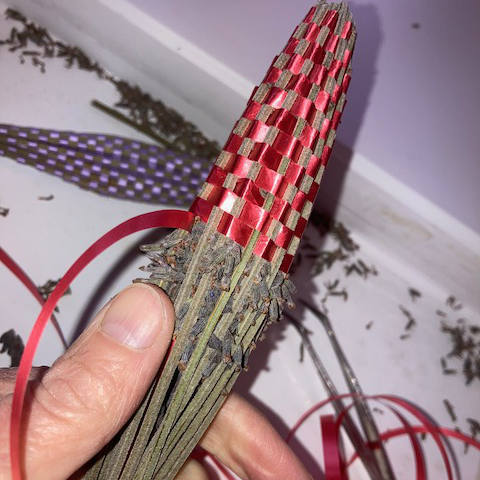 |
| November 29th | Casual Workday | |
| December 6th | Casual Workday | |
| December 13th | Business Meeting, Christmas Lunch | |
| December 20th | ||
| More Workshop Ideas | Inkle Loom Weaving Online weaving workshop with Elizabeth Calnan |
Last words ...
A few housekeeping items:
1 – Some members have been getting spam type emails saying they are coming from Guild members. If anyone gets a suspicious looking message, do not open them or any links within them.
2 – Please do not park in front of the Guild’s side double doors. This could cause a problem in the case of an emergency. Please park in the undercover area well clear of the doors and grandstand stairs, or on the grass area.
3 – The drain area outside the Guild door that fills up with water when it rains is becoming DANGEROUS with one of our members slipping in the mud and algae growing there. PLEASE KEEP WELL CLEAR OF THE DRAIN AND MUD even when it appears dry!
Newsletter contributions are always welcome. So, if anyone has anything they want to contribute, or requests for articles, email me!
Cheers for now,
KathyW, Ed.
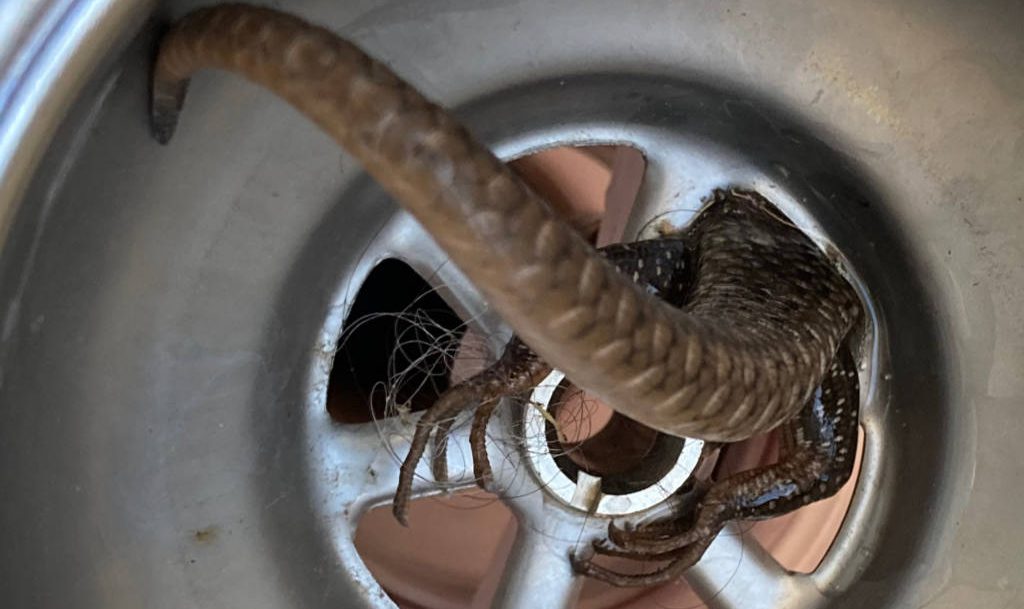
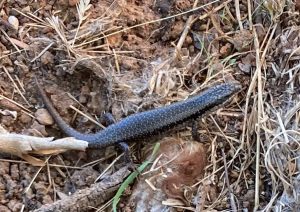 Not even remotely what I was expecting when I went to scour some fleece – a lizard stuck fast in the plug hole of my fleece washing tub! The lizard was safely removed unharmed and returned to the garden where it belonged.
Not even remotely what I was expecting when I went to scour some fleece – a lizard stuck fast in the plug hole of my fleece washing tub! The lizard was safely removed unharmed and returned to the garden where it belonged.
